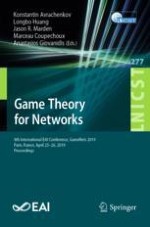2019 | Book
Game Theory for Networks
8th International EAI Conference, GameNets 2019, Paris, France, April 25–26, 2019, Proceedings
Editors: Dr. Konstantin Avrachenkov, Longbo Huang, Jason R. Marden, Marceau Coupechoux, Anastasios Giovanidis
Publisher: Springer International Publishing
Book Series : Lecture Notes of the Institute for Computer Sciences, Social Informatics and Telecommunications Engineering
